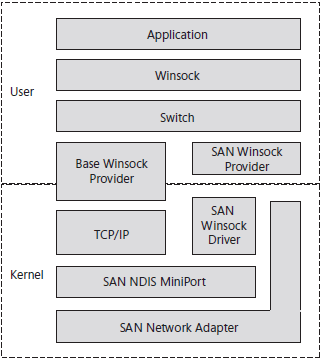Windows Sockets Direct Path for System Area Networks
Windows Sockets Direct (WSD) enables Winsock applications that use TCP/IP to obtain the performance benefits of system area networks (SANs) without application modifications. SANs are a type of high-performance network often used for computer clusters.
WSD allows communications across a SAN to bypass the TCP/IP protocol stack, taking advantage of the reliable, direct communications provided by a SAN. In Windows Vista and Windows 7, this is implemented by adding a virtual switch between Winsock and the TCP/IP stack. This switch has the ability to examine traffic and pass communications to a SAN Winsock provider, bypassing TCP/IP entirely. Figure below illustrates this architecture.

In this tutorial:
- Configuring Windows Networking
- Usability Improvements
- Network And Sharing Center
- Network Explorer
- How Windows Finds Network Resources
- How Windows Publishes Network Resources
- How Windows Creates the Network Map
- Network Map
- Set Up A Connection Or Network Wizard
- Manageability Improvements
- Network Location Types
- Policy-Based QoS
- Selecting DSCP Values
- Planning Traffic Throttling
- Configuring QoS Policies
- Configuring System-Wide QoS Settings
- Configuring Advanced QoS Settings
- Testing QoS
- Windows Firewall and IPsec
- Windows Connect Now in Windows 7
- Core Networking Improvements
- Networking BranchCache
- How Hosted Cache Works
- How Distributed Cache Works
- Configuring BranchCache
- BranchCache Protocols
- File Sharing Using SMB
- Web Browsing with HTTP (Including HTTPS)
- DNSsec
- GreenIT
- Efficient Networking
- What Causes Latency, How to Measure It, and How to Control It
- TCP Receive Window Scaling
- Scalable Networking
- Improved Reliability
- IPv6 Support
- 802.1X Network Authentication
- Server Message Block (SMB) 2.0
- Strong Host Model
- Wireless Networking
- Improved APIs
- Network Awareness
- Improved Peer Networking
- Services Used by Peer-to-Peer Networking
- Managing Peer-to-Peer Networking
- Peer-to-Peer Name Resolution
- EAP Host Architecture
- Layered Service Provider (LSP)
- Windows Sockets Direct Path for System Area Networks
- How to Configure Wireless Settings
- Configuring Wireless Settings Manually
- Using Group Policy to Configure Wireless Settings
- How to Configure TCP/IP
- DHCP
- Configuring IP Addresses Manually
- Command Line and Scripts
- How to Connect to AD DS Domains
- How to Connect to a Domain When 802.1X Authentication Is Not Enabled
- How to Connect to a Domain When 802.1X Authentication Is Enabled
